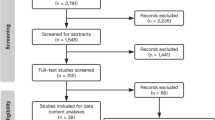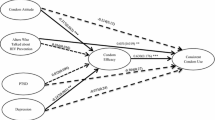Abstract
Effective sexually transmitted infection (STIs)/HIV prevention programs are urgently needed, but translating evidence-based methods of STI/HIV prevention into sustainable programs has been difficult. Social influences are critical for establishing condom use norms. This study systematically reviewed social network-based interventions focused on condom promotion. Social networks were defined as groups who self-identified prior to the research study. Eleven eligible research studies were identified and included in this review. Only three studies measured biological endpoints and five studies used validated measures of condom use. Among the nine studies with control groups, eight showed significant improvements in at least one measure of condom use. There were large differences in how social network members were identified and involved in the interventions. This systematic review highlights the potential utility of social network-based condom promotion programs. More research is needed to show how these promising studies can be expanded.
Resumen
Intervenciones para promover el uso de preservativos basados en las redes sociales: Una reseña sistemática Se necesita urgentemente programas efectivos para prevenir enfermedades de transmisión sexual y SIDA, pero ha sido difícil traducir métodos basados en evidencia de prevención a programas sostenibles. Influencias sociales son esenciales para establecer el uso de preservativos como una norma social. Esa reseña sistemáticamente examinó intervenciones basados en las redes sociales que se enfocaba en promoción del preservativo. Se definieron las redes sociales como grupos quienes se identificaron ellos mismos antes de estar en la investigación. Se identificaron y se incluyeron once investigaciones que reunieron los requisitos necesarios en esta reseña. Solo tres investigaciones evaluaron finales biológicos y cinco investigaciones usaron medidas validas del uso de preservativo. Entre las nueve investigaciones con grupos de control, ocho enseñaron mejora significante en a lo menos una medida del uso de preservativo. Había diferencias grandes en cómo se identificaron y se involucraron los miembros de las redes sociales en las intervenciones. Esta reseña sistemática demuestra la utilidad potencial de programas para promover el uso de preservativos a través de las redes sociales. Se necesita más investigación para demostrar cómo estas estudias promovedoras pueden desarrollar.

Similar content being viewed by others
References
Glasier A, Gulmezoglu AM, Schmid GP, Moreno CG, Van Look PF. Sexual and reproductive health: a matter of life and death. Lancet. 2006;368(9547):1595–607.
Holmes KK, Levine R, Weaver M. Effectiveness of condoms in preventing sexually transmitted infections. Bull World Health Organ. 2004;82(6):454–61.
Rojanapithayakorn W. The 100% Condom Use Programme in Asia. Reprod Health Matters. 2006;14(28):41–52.
Ellen JM. The Next generation of HIV prevention for adolescent females in the United States: linking behavioral and epidemiologic sciences to reduce incidence of HIV. J Urban Health. 2003;80(4):iii40–9.
Seal DW, Ehrhardt AA. HIV-prevention-related sexual health promotion for heterosexual men in the United States: pitfalls and recommendations. Arch Sex Behav. 2004;33(3):211–22.
Valente TW. Social networks and health: models, methods and applications. New York: Oxford University Press; 2010.
Koblin B, Chesney M, Coates T, Team ES. Effects of a behavioural intervention to reduce acquisition of HIV infection among men who have sex with men: the EXPLORE randomised controlled study. Lancet. 2004;364(9428):41–50.
Charania MR, Crepaz N, Guenther-Gray C, Henny K, Liau A, Willis LA, et al. Efficacy of structural-level condom distribution interventions: a meta-analysis of U.S. and international studies, 1998–2007. AIDS Behav. 2010. doi:10.1007/s10461-010-9812-y.
Albarracin D, Tannenbaum MB, Glasman LR, Rothman AJ. Modeling structural, dyadic, and individual factors: the inclusion and exclusion model of hiv related behavior. AIDS Behav. 2010;14:S239–49.
Latkin C, Weeks MR, Glasman L, Galletly C, Albarracin D. A dynamic social systems model for considering structural factors in HIV prevention and detection. AIDS Behav. 2010;14:S222–38.
Amirkhanian YA, Kelly JA, Kabakchieva E, McAuliffe TL, Vassileva S. Evaluation of a social network HIV prevention intervention program for young men who have sex with men in Russia and Bulgaria. AIDS Educ Prev. 2003;15(3):205–20.
Choi KH, Gregorich SE. Social network influences on male and female condom use among women attending family planning clinics in the United States. Sex Transm Dis. 2009;36(12):757–62.
Lippman SA, Donini A, Diaz J, Chinaglia M, Reingold A, Kerrigan D. Social-environmental factors and protective sexual behavior among sex workers: the Encontros intervention in Brazil. Am J Public Health. 2010;100(Suppl 1):S216–23.
Tucker JD, Yang LG. Low-income FSWs, Social Networks, and STI/HIV Prevention. UNC R24 Conference. Liuzhou, China. May 31st, 2011.
Latkin CA. Outreach in natural settings: the use of peer leaders for HIV prevention among injecting drug users’ networks. Public Health Rep. 1998;113(Supplement 1):151–9.
Fang X, Stanton B, Li X, Feigelman S, Baldwin R. Similarities in sexual activity and condom use among friends within groups before and after a risk-reduction intervention. Youth Soc. 1998;29(4):431–50.
Latkin CA, Sherman S, Knowlton A. HIV prevention among drug users: outcome of a network-oriented peer outreach intervention. Health Psychol. 2003;22(4):332–9.
Sherman SG, Sutcliffe C, Srirojn B, Latkin CA, Aramratanna A, Celentano DD. Evaluation of peer network intervention trial among young methamphetamine users in Chiang Mai, Thailand. Soc Sci Med. 2009;68(2009):69–79.
Booth RE, Lehman WEK, Latkin CA, Dvoryak S, Brewster JT, Royer MS, et al. Individual and network interventions with injection drug users in 5 Ukraine cities. Am J Public Health. 2011;10(2):336–43.
Odek WO, Busza J, Morris CN, Cleland J, Ngugi EN, Ferguson AG. Effects of micro-enterprise services on HIV risk behavior among female sex workers in Kenya’s urban slums. AIDS Behav. 2009;13:449–61.
Amirkhanian YA, Kelly JA, Kabakchieva E, Kirsanova AV, Vassileva S, Takacs J, et al. A randomized social network HIV prevention trial with young men who have sex with men in Russia and Bulgaria. AIDS. 2005;19:1897–905.
Tobin KE, Kuramoto SJ, Davey-Rothwell MA, Latkin CA. The STEP into action study: a peer-based, personal risk network-focused HIV prevention intervention with injection drug users in Baltimore, Maryland. Addiction. 2010;106(2):366–75.
Davey-Rothwell MA, Tobin K, Yang C, Sun CJ, Latkin CA. Results of a randomized controlled trial of a peer mentor HIV/STI prevention intervention for women over an 18 month follow-up. AIDS Behav. 2011. doi:10.1007/s10461-011-9943-9.
Kelly JA, Amirkhanian YA, Kabakchieva E, Vassileva S, McAuliffe TL, DiFranceisco WJ, et al. Prevention of HIV and sexually transmitted diseases in high risk social networks of youn Roma (Gypsy) men in Bulgaria: randomized controlled trial. BMJ. 2006;333(7578):1098.
World Bank country classifications. Washington DC 2011 [2011]; Available from: http://data.worldbank.org/about/country-classifications/country-and-lending-groups#Low_income. Accessed July 2, 2011.
Free C, Roberts IG, Abramsky T, Fitzgerald M, Wensley F. A systematic review of randomised controlled trials of interventions promoting effective condom use. J Epidemiol Community Health. 2011;65:100–10.
Latkin CA, Forman V, Knowlton A, Sherman S. Norms, social networks, and HIV-related risk behaviors among urban disadvantaged drug users. Soc Sci Med. 2003;56(3):465–76.
Latkin C, Donnell D, Celentano DD, Aramrattna A, Liu T-Y, Vongchak T, et al. Relationships between social norms, social network characteristics, and HIV risk behaviors in Thailand and the U.S. Health Psychol. 2009;28(3):323–9.
Yang C, Latkin C, Luan R, Nelson K. Peer norms and consistent condom use with female sex workers among male clients in Sichuan province, China. Soc Sci Med. 2010;71(4):832–9.
Acknowledgment
The authors would like to thank Professor Carl Latkin for helpful comments on an earlier version of this manuscript. The authors would also like to thank Bonnie Tucker for translating the abstract.
Author information
Authors and Affiliations
Corresponding author
Additional information
Kaidi Wang and Katherine Brown contributed equally to this manuscript.
Electronic supplementary material
Below is the link to the electronic supplementary material.
Rights and permissions
About this article
Cite this article
Wang, K., Brown, K., Shen, SY. et al. Social Network-Based Interventions to Promote Condom Use: A Systematic Review. AIDS Behav 15, 1298–1308 (2011). https://doi.org/10.1007/s10461-011-0020-1
Published:
Issue Date:
DOI: https://doi.org/10.1007/s10461-011-0020-1




